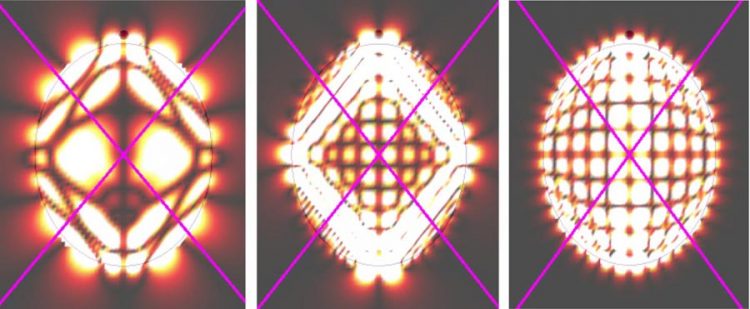Trapped light orbits within an intriguing material

Patterns of orbiting light predicted for spheroids of hexagonal boron nitride illuminated with a dipole source just above their north poles. These are false-color plots of predicted hot spots of enhanced electrical fields. Magenta lines trace the periodic orbits on the surfaces set up by particular frequencies. Credit: Fogler group, UC San Diego
Hexagonal boron nitride, stacked layers of boron and nitrogen atoms arranged in a hexagonal lattice, has recently been found to bend electromagnetic energy in unusual and potentially useful ways.
Last year Fogler and colleagues demonstrated that light could be stored within nanoscale granules of hexagonal boron nitride. Now Fogler's research group has published a new paper in the journal Nano Letters that elaborates how this trapped light behaves inside the granules.
The particles of light, called phonon polaritons, disobey standard laws of reflection as they bounce through the granules, but their movement isn't random. Polariton rays propagate along paths at fixed angles with respect to the atomic structure of the material, Folger's team reports. That can lead to interesting resonances.
“The trajectories of the trapped polariton rays are very convoluted in most instances,” Fogler said. “However, at certain 'magic' frequencies they can become simple closed orbits.”
When that happens “hot spots” of strongly enhanced electrical fields can emerge. Fogler's group found those can form elaborate geometric patterns in granules of spheroidal shape.
The polaritons are not only particles but also waves that form interference patterns. When overlaid on the hot contours of enhanced electrical fields, these create strikingly beautiful images.
“They resemble Fabergé eggs, the gem-encrusted treasures of the Russian tsars,” Fogler observed.
Beyond creating beautiful images, their analysis illustrates the way light is stored inside the material. The patterns and the magic frequencies are determined not by the size of the spheroid but its shape, that is, the ratio of its girth to length. The analysis revealed that a single parameter determines the fixed angle along which polariton rays propagate with respect to the surface of the spheroids.
Scientists are beginning to find practical uses for materials such as hexagonal boron nitride that manipulate light in usual ways. The theory this work informed could guide the development of applications such as nanoresonators for high-resolution color filtering and spectral imaging, hyperlenses for subdiffractional imaging, or infrared photon sources.
The analysis provides a theoretical explanation for earlier observations of trapped light. Fogler and colleagues suggest several experiments that could confirm their prediction of orbiting light using advanced optical techniques, some of which are underway, Fogler said. “The experimental quest to detect orbiting polaritons has already begun.”
###
Additional authors include Zhiyuan Sun, a graduate student in Fogler's research group, Angel Guttiérrez-Rubio of the Spanish National Research Council (CSIC) who contributed to the project while a visiting scholar at UC San Diego, and Dimitri Basov, a professor of physics at UC San Diego. The UC Office of the President, U.S. Department of Energy, Spanish Ministry of Economy and Competitiveness, and European Research Council supported the work.
Media Contact
All latest news from the category: Materials Sciences
Materials management deals with the research, development, manufacturing and processing of raw and industrial materials. Key aspects here are biological and medical issues, which play an increasingly important role in this field.
innovations-report offers in-depth articles related to the development and application of materials and the structure and properties of new materials.
Newest articles

Silicon Carbide Innovation Alliance to drive industrial-scale semiconductor work
Known for its ability to withstand extreme environments and high voltages, silicon carbide (SiC) is a semiconducting material made up of silicon and carbon atoms arranged into crystals that is…

New SPECT/CT technique shows impressive biomarker identification
…offers increased access for prostate cancer patients. A novel SPECT/CT acquisition method can accurately detect radiopharmaceutical biodistribution in a convenient manner for prostate cancer patients, opening the door for more…

How 3D printers can give robots a soft touch
Soft skin coverings and touch sensors have emerged as a promising feature for robots that are both safer and more intuitive for human interaction, but they are expensive and difficult…





















